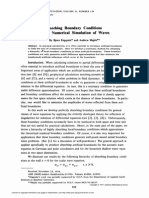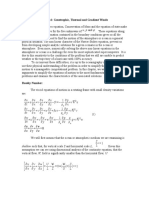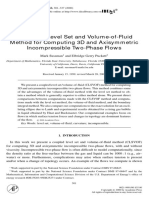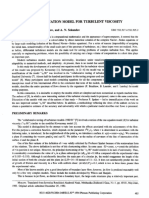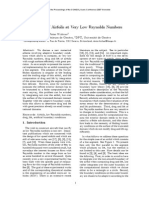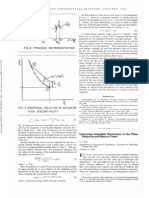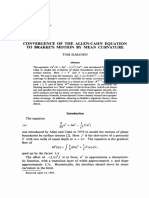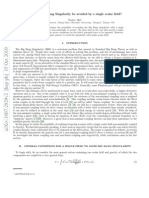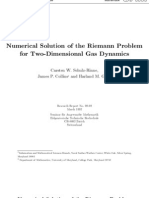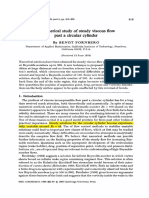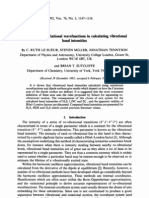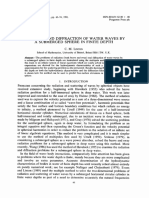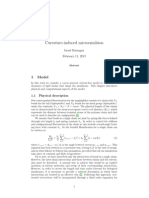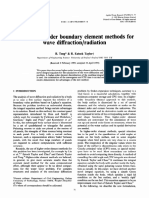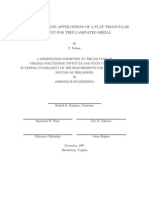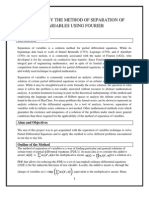Inst of Mathematical Sciences Conditions For Wave-Like Equations. (U) Dec 79 A Bayliss-E Turkel
Inst of Mathematical Sciences Conditions For Wave-Like Equations. (U) Dec 79 A Bayliss-E Turkel
Uploaded by
suvabrata_das01Copyright:
Available Formats
Inst of Mathematical Sciences Conditions For Wave-Like Equations. (U) Dec 79 A Bayliss-E Turkel
Inst of Mathematical Sciences Conditions For Wave-Like Equations. (U) Dec 79 A Bayliss-E Turkel
Uploaded by
suvabrata_das01Original Title
Copyright
Available Formats
Share this document
Did you find this document useful?
Is this content inappropriate?
Copyright:
Available Formats
Inst of Mathematical Sciences Conditions For Wave-Like Equations. (U) Dec 79 A Bayliss-E Turkel
Inst of Mathematical Sciences Conditions For Wave-Like Equations. (U) Dec 79 A Bayliss-E Turkel
Uploaded by
suvabrata_das01Copyright:
Available Formats
AD-AO94 881
UNCLASSIFIED
SCIENCES
NEW YORKUNIV NY COURANTINST OF MATHEMATICAL
(U)
CONDITIONS FOR WAVE-LIKE EQUATIONS.
RADIATION BOUNDARY
NASI-14101
DEC 79 A BAYLISS- E TURKEL
F/B 12/1
IL
MICRO)COPYRf SOL I ION II SI
CHARTI
)Radiation
Boundary Conditions for Wave-Like
Io quations
i
1S
J~7'~ALVINbAL
Insite
CO
1 j r,
puate
tpp onsin Scice and E gineefing and
/C
ouran Institute
-AND
Courant 1
of Tel Aviv7
Abstract
In the numerical computation of hyperbolic equations it is not practical to use infinite
omains. Instead, one truncates the domain with an artificial boundary. In this study we construct
sequence of radiating boundary condtions for wave-like equations. We prove that as the
tificial boundary is moved to infinity the solution approaches the solution of the infinite domain
as 0(r-'-"') for the rn-tb boundary condition. Numerical experiments with problems in jet
acoustics verify the practical nature and utility of the boundary conditions.
1. Introduction
In many problems of interest one wishes to solve time-dependent equations in an infinite domain. Examples of such situations include jet acoustics.
seismology, exterior aerodynamics, exterior ballistics, astrophysics, and laser
fusion. However, for computational expediency one is required to operate
within a bounded domain. One possibility is to map the infinite domain onto
a bounded one. However, in many circumstances this mapping can aggravate
the situation, especially when the solution is oscillatory at infinity, or when
the mapping has a singularity (see e.g., [9]). An alternative possibility is to
construct an artificial boundary and to impose conditions on this surface to
simulate an infinite domain, It is therefore desirable that there should be no
reflections from the boundary back into the domain of interest. Unless certain
restrictions are met this will not generally be possible.
In general one cannot construct boundary conditions that give no reflections. Instead one wishes to construct a sequence of boundary conditions that
are in some sense better. The notion of better can he defined in many ways.
Some of these are:
(i) the reflections decrease rapidly as the position of the artificial boundary
goes to infinity;
60i the reflections decrease for shorter wavelengths;
C" (iii) the reflections decrease as the incident wave approaches in a direction
D
more parallel to some preferred direction;
Communications on Pure and Applied Mathematics, Vol. XXXIII. 707-725 (1980)
(10(0-364018010031-0707501.90
1980 John Wiley & Sons. Inc.
7/
....
-J
/00-
708
A. BAYLISS AND E. TURKEL
(iv) the reflections are decreased in such a manner that the approach to a
steady state is accelerated.
One approach to decreasing reflections is to introduce a viscous region
near the boundary, or to introduce a sponge layer (see e.g., [19]). With this
approach it is not clear what effect the boundary layer has on the interior
dynamics. In addition it is difficult to improve these methods when one needs
to decrease the reflections further. Conditions (ii) and (iii) were used by
Engquist and Majda [4], [5] to construct an asymptotic set of nonreflecting
conditions with the help of the theory of pseudodifferential operators. Their
higher-order conditions require a Pade approximation for stability. Rudy and
Strikwerda [20] have constructed, by heuristic arguments, a radiation boundary condition based on (iv). In some cases it is possible to construct boundary
conditions based on separation of variables or integral relations satisfied by
the desired solution. This method was used by Fix and Marin [6] and Marin
[17] for the Helmholtz equation. Since the resulting boundary conditions are
nonlocal, i.e., they couple the solution at all points on the boundary, they can
not be readily applied to a standard finite-difference solution technique for
hyperbolic equations. For this reason, we concentrate on developing local
boundary conditions.
Gustafsson and Kreiss [11] have shown that in general one cannot
construct nonreflecting boundary conditions unless the behavior of the solution is known in a neighborhood of infinity. We adopt their concept and
construct boundary conditions which are based on an asymptotic expansion of
the solution valid for large distances. As with all asymptotic expansions, we
expect reasonable results even when the artificial boundary is quite close to
the domain of interest. Extensive numerical tests confirm that the domain of
integration can be very constricted when one uses the higher-order boundary
conditions. In fact for the Helmholtz equation, Ap+k 2 p=O, exterior to
simple bodies only five to ten mesh points are generally required normal to
the body, see [2].
The boundary conditions to be developed are based on an asymptotic
expansion in l/r, where r is the distance from a fixed point. These conditions
form a sequence of differential operators B, which, for any m, annihilate the
first m terms in the asymptotic expansion. A typical boundary condition has
the form
Bp = 0.
This can be considered as a way of matching the solution on the boundary to
the first m terms of the expansion of the solution exterior to the boundary.
The operator B~p was used by Kriegsman and Morawetz [14] for the
Helmholtz equation.
The details of this construction are described in Section 2. In Section 3 we
709
CONDMONS FOR WAVE-LIKE EOUATIONS
prove that these boundary conditions yield well-posed problems and that they
satisfy (i) in that the m-th boundary condition is accurate to an error of
O(r - 2 m+I). Numerical computations presented in [3] demonstrate that these
boundary conditions are also good for accelerating the solution to a steady
state, as in condition (iv).
As a specific example we consider the Euler equations in cylindrical
coordinates and with axial symmetry, linearized about a mean velocity profile
(uo, Vo),
p,+(puo+u).+(pvo+v),+Pv+V=F,,
(1.1)
u,
+ (UUo + p) + (UVo)d = UVo~d -VUo.d
v, + (vu)
+ F2 ,
+ (vvO + P)d = VUo.z - UVo.. + F 3 .
Here p, u, and v are the perturbation pressure and velocities, respectively,
while z and d are the axial and radial coordinates. (We use the nonstandard
notation d since r will be used throughout as the spherical radius, r 2 = z 2 +
d'.) The mean pressure Po is assumed constant and the equations are scaled
so that po= 1 and co = 1, where co is the ambient sound speed; F denote
source terms.
The system (1.1) with appropriate source terms and initial conditions
describes the propagation of acoustic waves in the mean flow (uo, v,). It
also describes the growth of small disturbances in this flow and with
appropriate initial conditions the system is used to study the linear stability of
the mean flow.
In order that it be feasible to integrate (1.1) in a bounded domain, it is
necessary to assume that the mean flow and the forcing terms tend to a
constant as r goes to infinite (see [11]). We shall assume that uo, vo, F all
decay to zero at infinity. A more general case is described in Section 5.
Hence, for large r, (1.1) can be approximated by
p, + Ud + Vd +
(1.2)
=0,
u,+p =0,
V,+Pd =0,
or equivalently,
(1.3)
p, -Ap = 0 .
For the system (1.2) (or the equation (1.3)) an asymptotic expansion does
exist for which radiation boundary conditions can be developed.
C ,
ii
C 4 C:
in
710
A. BAYLISS AND E. TURKEL
The radiation boundary conditions for (1.2) and (1.3) are constructed in
Section 2. Special attention is paid to the numerical approximations to these
conditions. In Section 5 several generalizations are considered. These include
the convective wave equation, two-dimensional cartesian systems and also the
Helmholtz and Laplace equations. Further discussion of some of these
generalizations are presented in [2] and [3].
2. Boundary Conditions
Based on a separation of variables, one can heuristically show that
radiating solutions p to the wave equation have an expansion of the form
(2.1)
-r,,
P(t, r, 0,40)= i=1
Here r, 0, are spherical coordinates centered at a fixed origin in space. The
expansion (2.1) is well known. Friedlander [7] has proven that if f1 (s, 0, 40) is
an analytic function of 0 and 4, then the series in (2.1) is convergent. It is a
consequence of the integral representation, using the retarded potential, of
solutions to the wave equation, that (2.1) will hold as an asymptotic
expansion in 1/r under mild smoothness conditions (see for example [1]).
Given (2.1) we can derive boundary conditions which are accurate on the
boundary, to any order in 1/r.
We define the operator
a a
at
ar
If (2.1) is multiplied by r", we obtain
(2.2)
rmp(t. r,O8, tb=
rk 1M t-rO, b+
rk-if(-r,O,0).
Applying the operator L" to both sides of (2.2) we see that the first sum is
annihilated and the leading term of the second sum is O(r - ' - '). Hence.
(2.3)
L'(r"p)=O(r '
).
We wish to rewrite this expression as an operator acting only on p. Therefore,
CONDITIONS FOR WAVE-LIKE EQUATIONS
711
we recursively define the operators
(2.4)
B, - L
r
(2.5)
B,, = (L+
2m
B_ =
(L+
)B _
This can be expressed as
(2.6)
21
-1),
where the order of the products is given by (2.5). It then follows from (2.3)
that
(2.7)
Bmp =
0(1/r
+1),
for any function p which satisfies the expansion (2.1). In fact, B., annihilates
the first m terms in the expansion (2.1). This property is derived by using
formal manipulations with (2.1) and does not use any other properties of the
wave equation.
We propose therefore the family of boundary conditions
(2.8)
B,,,p=O.
By (2.7) this is a sequence of boundary conditions for the wave equation (or
for any system for which (2.1) holds) with increasing accuracy in l/r. The
equation (2.8) holds identically for the first m terms in the expansion (2.1).
The operators Bm are linear differential operators of order m which can be
considered as a measure of the difficulty in their implementation. We show
first that the operators B., are optimal in this measure. It is obvious from the
above derivation that the B. are unique up to a constant and that the
following theorem is true.
THEOREM
2.1.
Let Q be any linear differential operator which annihilates
f,(t - r, A,O)/ri for j = 1,. ., m for arbitrary fi. Then the order of 0 is at least
m. If 0 has order m, then Q = cB for any function c(r, t).
A two-dimensional version based on B, p = 0 was introduced by Engquist
and Majda (5] as the first approximation in a series of boundary operators.
These operators are based on an expression in the angle of the wave
measured with respect to the normal to the boundary. In this study the
boundary operators are asymptotic in powers of l/r.
When the operator a/8r is used for nonspherical boundaries both normal
and tangential derivatives to the boundary appear. For the normal derivatives
712
A. BAYLISS AND E. TURKEL
one-sided differences must be used. In general, one requires that the
numerical approximation to these derivatives be no less than one order of
accuracy less than the accuracy of the interior scheme (cf. [10]). Hence, the
normal derivatives appearing in B. for large m will involve many mesh
points normal to the boundary. This may present stability and accuracy
difficulties. It is therefore desirable to implement the boundary conditions
without using high-order normal derivatives.
We can introduce a local cartesian coordinate system. The wave equation
Pn =Ap
can then be used to express all normal derivatives of order greater than one
in terms of tangential and time derivatives. When working with the first-order
system
p,+div w= 0,
(2.9)
w, + grad p = 0,
the first-order normal derivative of p can also be eliminated in terms of time
derivatives. With the first-order system the number of time derivatives
required is reduced. This is desirable for computational reasons since it is
easier to calculate two k-th order time derivatives rather than a (k + 1)-st order
time derivative.
It thus follows that when the system (2.9) is used, no normal derivatives
occur in the equation B,,p -0.The system (2.9) arises naturally in the study
of the linearized Euler equations (1.1). For this case no second-order wave
type equation can be derived when the mean flow is nonzero. The system
(2.9) is also advantageous in that the boundary values for p and w can be
obtained by standard finite difference algorithms. This is preferable to using
one-sided differences for a nonstandard boundary condition which would
complicate a stability analysis.
The first two boundary conditions written in cylindrical coordinates z and
d are given explicitly by
(2.10)
Blp =p,+w,+-r
and
B 2 = p.-(2w.+ w.)
4p,
pr- w1 2p
"
(2.11)
where r
2
=z
+d , tan
7 1
8O=d/z, and w v cos O+v sin .
713
CONDITIONS FOR WAVE-LIKE EQUATIONS
3. Welposeldess
We have constructed the operators B. given by (2.5), so that they form a
sequence of more accurate boundary approximations. This does not guarantee
that the ensuing problems are well posed. In [4] a different sequence of
absorbing boundary conditions was developed, some of which gave rise to
ill-posed problems. When Pad6 approximations are used instead of a Taylor
series, the ensuing boundary conditions are all stable. For computational
efficiency, it is important that the initial boundary value problem be well
posed for relatively general boundary shapes.
We consider the two-dimensional case but all proofs extend to three
-- <y<-. We then have,
dimensions. The region of integration is x -0,
along the boundary x = 0,
(3.1)
a =r a +b!y
8r
ax
ay
with
a 2 +b 2 = 1.
Since the interior is x <0, we have a >0.
We define the q norm for the interior solution as
Y- I
jllUlllC.O=
I 1-o afI
dx dr.
TI
Here, j is a multi-index, x represents all the space dimensions, C= (x, t) and
0 is the domain of the problem. Similarly we define the L2 norm of the
boundary data as
jjgjL = J
g2 dy dt.
Now, at is the boundary of 01 and y represents the tangential variables.
THEOREM
(3.2a)
(3.2b)
3.1.
Consider the problem
p, =,&p + F,
p E 11,
Bmp = g,
peaf0,
where
(3.2c)
B.= -0 (a+a-+b
-cy +*,r)/
ax
a0t
a 2+b 2 =1,
a>O,
714
A. BAYLISS AND E. TURKEL
the aj being constants that depend on the dimension (see (2.5)-(2.6) and (5.4)).
We then have the estimate
(3.3)
jIpIL.n + lpIl~a < K[BjgjLn + JIF14a],
q =0, 1,.-., m.
Proof: The weliposedness of hyperbolic initial boundary value problems
was studied by Kreiss [13] and it is assumed that the reader is familiar with
this theory.
For the boundary condition B,,p = 0 it is sufficient to consider only the
highest-order derivatives that appear. We also restrict ourselves to the
domain x 0. For simplicity we assume that F 0. We thus need only
consider
(3.4a)
p. = p. + p",
x O,-_ < y< 0,
and
(3.4b)
Lp = g
along
x = 0,
where
L =-+a
(3.4c)
8t
--+b ox
Oy
If
9Re s>s0,,q real,
g = eSleirg,
then there are solutions
(3.5)
p = e e"y-O(x),
provided that c satisfies
(3.6a)
0. = A24,
x 5-0,
where
(3.6b)
A= (sl+ 712)1/2
Re A>0,
and also
(3.7)
1al+s+ibi jb=
at
x=O.
CONDITIONS FOR WAVE-LIKE EQUATIONS
Restricting 41 so that 40 E L 2(--,
715
0), the solution to (3.6a) is
4i=Ae'.
(3.8)
Substituting (3.8) into (3.7) we have
,
d,(A, s, ni)(1 + Isj)' 4 5 = je
(3.9a)
-0<x <0,
q=l.".-.
or
d;(ak + s + ibl
-})
dq=aA
(3.9b)
According to the theory of [13] we must eliminate the possibilities of
eigenvalues or generalized eigenvalues to
D
(3.10)
aA+s+ibq=0.
Re s>0 implies that SieD>O and so no eigenvalues to (3.10) exist. To
consider the possibility of generalized eigenvalues we let A = Al +iA 2 , s=
sl+ is2 . Squaring (3.6b) it is clear that the possible generalized eigenvalues
are characterized by either
(3.1 1a)
Xm= s,= 0,
Is1l
L, 2>0,
S2
or
(3.11b)
=S 1 =0,
Is2 1< vIf.
For the first possibility, 0m D>0 since jbI< 1, and for the second possibility,
Ote D= aA1 #0. Hence, in any case we can not have solutions to (3.10) with
Re s>0 or those that are limits of solutions with Rie s>0.
Remarks. 1. The proof fails when a = 0. It is readily seen that (3.2c) is not
well posed for such boundary points. This corresponds to using a ray
0 = constant as part of the artificial surface. Such boundaries arise naturally in
polar coordinates. Hence, the use of cylindrical coordinates may offer
numerical benefits.
2. For m = 1 we can obtain the estimate (3.3) by an energy method.
Consider system (3.4) and let
(3.12)
E=
(p+ p2+ p'+ 2bpp,) dx dy.
716
A. BAYLISS AND E. TURKEL
Then
dE
(3.13)
(ap 2 + gp.)dy- -2a
-_
dt
)dy.
(p.2a
In particular this shows that there are no eigenvalues or generalized eigenvalues to d, =0 for q = 1. From the form of dq in (3.9b) it immediately
follows that for any m there are no eigenvalues or generalized eigenvalues
when q=l,...,m.
We can use the results of this theorem to get an estimate of the error
generated by the boundary conditions. More specifically, we have
THEOREM
3.2.
Let p be the solution to the infinite domain problem, i.e.,
(3.14)
p,, =Ap + F,
xC=R,
and let u_ be the solution to (3.2), the wave equation in the finite domain, with
the boundary condition Bmu. = 0. Let R be a measure of the size of the
artificial domain f) and let e,, = p - u.. Then
lem Lm. = O(m
(3.15)
Proof:
).
v. satisfies the differential system
(3.16a)
E,.,, = AE.,
(3.16b)
BmEm= Bmp,
x E Cfl.
In view of Theorem 3.1 we know that
(3.17)
jlen,
.- K,5 IIB,,pIL .
Since p is a solution to the wave equation in R3 , p can be expanded in terms
of the traveling wave expansion (2.1). From the construction of B., we saw
in (2.7) that
II~mn.R 2m +1
We, therefore, have
(3.18)
I1jm.I.,-K.O(
r-t)
R.+
CONDITIONS FOR WAVE-LIKE EQUATIONS
717
It remains to find the dependence of Km on R. We consider a fixed domain
with size measured by R0 . As the size of the artificial domain increases we
introduce the change of variables
I'= t/Ro,
x'=x/R 0 .
Using this scaling in (3.18), the estimate (3.15) follows. If the equation to be
integrated is not identically the wave equation, but approaches the wave
equation sufficiently rapidly for large r, then (3.15) can be generalized.
In Theorem 3.2 we have considered the order of the boundary operator
B_ as fixed and let R increase. In practical calculations, one would like to
reverse the situation, i.e., keep R fixed and increase the accuracy by
increasing the order of the boundary operator. Extensive computations with
m equal to one and two confirm the superiority of B2 over B, in a fixed
domain. We have been able to bring in the artificial boundary extremely close
to the region in which the variation of the inhomogeneities is large and still
obtain good accuracy when using B2. This was done for a series of problems
with different sources modeling various physical processes. The equations
have coefficients with large gradients near the axis of symmetry and so are
not close to the wave equation in this region. Different boundary configurations were used to model free space or a bounding wall above the nozzle exit.
In all these cases the second-order condition, B 2 P =0, gave very accurate
results. For the simpler cases, the first-order approximation Bjp =0 was
adequate. The characteristic condition, p + p, =0, was not useful and tended
to give rise to large spurious reflections. This is intuitively obvious since p,
and p, are both going to zero due to the spreading of waves in multidimensional problems. The essence of the Sommerfeld radiation condition is
the rate of decay which is not included in the simple condition that p,+ p,=0.
Hence, B, p = 0 is the minimal condition that is reasonable. The accuracy was
measured by varying the finite difference mesh as well as the position of the
artificial surface. More details of the computations are presented in the next
section.
4. Numerical Result
In this section we present some numerical results. These results are
primarily designed to demonstrate the improvements which can be obtained
by use of the second-order boundary condition B2P = 0 over the first-order
boundary condition Blp=O.
The computations will be made for the system (1.1). The computational
domain will be a cylindrical rectangle with an axial source. (See Figure 1.)
Because of the axial symmetry the problem reduces to two dimensions. At
the near field boundary (dotted line in the figure) different boundary
conditions are imposed.
718
A. BAYLISS AND E. TURKEL
a, p-0
Circle of
Vmeosuremeni
8,p=O
B p=O
Neat
__
field
boundary
- Source
\-Axis of
symmetry
Figure 1. Computational domain.
For the first experiments a jet flow is assumed to exit from a pipe of
radius 4 at the near field boundary. The cylindrical rectangle is 30 units high.
and 50 units in length. A source of the form
cos cot . 5(Ix - Xof)
is assumed with o = 1.055 in the above units. We plot the pressure versus
time at a fixed axial point 40 units from the source. (A Gaussian function was
used to model the 8 function.) Here we compare the characteristic condition
(4.1)
with the first-order condition
(4.2)
Bp = 0.
Results are shown in Figures 2 and 3. The spurious reflections generated by
(4.1) are evident from these figures.
For the remaining computations we consider the system (1.2) without any
mean flow so that the exact solution is known. Computations are now carried
out in a cylindrical square with each side of length 40 units. An important
case occurs when the radius is measured from an origin which is displaced
from the position of the source. Applications include the computation of the
jet interaction with two distinct sources. This information is useful for the
inverse problem, i.e., obtaining information about the sources based on far
field measurements (see Maestrello [161). Another important application is to
scattering by a body where the scattered field is the result of a distribution of
sources along the body (see [2]).
Therefore we consider a problem with the origin taken four units away
from the source position. A time harmonic point source of nondimensionalized frequency 1.055 is assumed. We compare the solutions for the
719
CONDITIONS FOR WAVE-UKE EOUATIONS
-
'000.00 X 1O 6
714.29
428.57
142.86.
e
s
s
S
r
-142.86
-429:.57
- ?14.P93
10
12
14X I0'
Time
Figure 2. Sommerfeld condition.
cases where BIp = 0 or B 2p = 0 are imposed along the near boundary (dotted
line in Figure 1). Since the mean flow is zero, the exact solution is a spherical
wave centered at the source position. We measure the total power as a
function of the angle 0,
(4.3)
i(8)=
p 2 dt.
This corresponds to the square of the amplitude of the spreading wave. In
Figure 4 we plot this function using the two different boundary conditions.
The solution is presented on a quarter circle of radius 20 and is normalized so
that the exact solution has an amplitude of 1. The improvement due to the
second-order condition is evident from Figure 4. In particular, the use of the
first-order boundary condition creates a large 0 dependence even though the
analytic solution is independent of 0. The accuracy of any of these boundary
conditions may deteriorate as w increases. This can happen, for example,
720
A. BAYLISS AND E.TURKEL
1000.00 x to-$
714.29
428.57
P
S
Tim
Figure 3. B II =O.
0 Second order condifloi
1.5
X First order condition
1.3
1.2
P'rmS
A--
10
20
30
40
50
60
70
s0
90
Figure 4. Relative power output for different boundary conditions.
CONDITIONS FOR WAVE-LIKE EQUATIONS
721
when the number of wave lengths between the origin and the source position
is large.
As a third example we consider a quadrupole source. This is an important
test case since the theory of Lighthill [15] indicates that the sources of jet
noise can be regarded as arising from quadrupole sources. Thus, in the
right-hand side of the continuity equation (first equation in (1.1)) we impose a
forcing term of the form
cos wt8k. (Ix- X01)
(4.4)
where the second derivative of the delta function is obtained by differentiating a Gaussian function. The frequency a is again taken as 1.055.
The solution to this problem is given by Morse and Ingard (see [18], p.
314), in spherical coordinates,
p(t, r, 0) =
(4.5)
-sin(w(t-r))cos
(,o(t+sin ()
r))
(3c
0 1 cos (wr(t- r))
o4rrr
O- 1)J
The solution (4.5) indicates that the leading order term in the expansion (2.1)
(i.e., f,) becomes zero when 0= 1r. Thus, when the condition Blp =0 is
imposed, the computed solution would be expected to be inaccurate for
angles neai 90' , It is also evident from (4.5) that a phase change of 900 is to
be expected as 0 varies from zero to 21r. The problem (4.4) was chosen so
that B2p = 0 does not hold identically for the solution (4.5).
In Figure 5 the root mean square power is plotted as a function of the
angle 0. The normalization is obtained by the exact solution (4.5) at 0 = 0 .
From the figures we see that the first-order boundary condition is less
accurate even for angles near 0 = 0". It has been the experience of the authors
that localized boundary errors can introduce significant global errors for long
term integrations. The first-order boundary condition will generally give
accurate results only if f, (in the expansion (2.1)) is significantly larger than
the other terms.
The total power is not a good measure of the accuracy of the solution as 0
approaches 2r because the solution becomes very small there. A better
measure of the accuracy is the phase of the solution relative to the phase at
0 = 0. Examination of the exact solution (4.5) shows that as a function of time
the solution changes from a sine dependence at 0 = 0 to a cosine dependence
at 0 =-2r. Thus, there should be a time delay, i.e., phase change of JPr
between successive peaks at 0 = 2r. In Table I this is shown for the different
boundary conditions. (For these tests the time step, At, was chosen so that
722
A. BAYLISS AND E. TURKEL
2.0
1.9
1.6
/
X Second order boundary condition
0 First order boundory condition
1.6
1.5
1.4
1.3
9.2
/
/
1.1
.6
.5
.4
.3
.2
.i
1
0
10
20
30
40
50
60
70
so
90
Figure 5. Relative power for quadruple.
Af= 0.08. Hence, the phase change can only be computed with this
accuracy.)
The fact that the computational domain has a corner can give rise to
instabilities when matching two different boundary conditions. In these test
runs the problem was not encountered since the corner is far from the
domain of interest. This difficulty can be overcome by interfacing the
boundary conditions as indicated by Engquist and Majda [5].
We point out that in order to obtain good accuracy it is essential to use a
fourth-order difference scheme for solving (1.1) (see [8]). This also requires a
high-order approximation to the boundary operators. This is not difficult since
the boundary condition can be reformulated so that only tangential derivatives are involved (Theorem 2.2). Fourth-order central differences are then
used to approximate the tangential derivatives.
Table I
hi'bae change.
Order of B.C.
Phase change
1
2
0.77A+0.08
1.64*0.08
CONDITIONS FOR WAVE-LIKE EOUATIONS
723
5. Extenotns
In the previous sections we have concentrated on the three-dimensional
wave equation in spherical or cylindrical coordinates. The only case considered so far is that of equations that tend to the wave equation in the far
field. In this section we investigate extensions to two-dimensional problems
the convective wave equation and also to elliptic equations. We shall only
introduce formal manipulations. Proofs of the utility of these boundary
conditions will be presented in future papers.
We assume first that p(x, t) = e-13(x). Then #(x) satisfies the Helmholtz
equation
2
Al5+k
(5.1)
= 0.
The boundary operators B,,, given by (2.5) can be applied to (5.1) by
formally replacing O/Ot by -ik. Alternatively, we can derive these boundary
conditions by looking at the analogue of the traveling wave expansion (2.1).
We then have
e-ik"
=e
(5.2)
me .
For the Helmholtz equation, Wilcox [21] has proven that (5.2) is a convergent
series. We then consider the boundary operators
(53)
-- m
(5.3
B,=\
ik+
(
+21-1
Or
r/
As before this product is taken by first operating with the index 1 = 1 and
continuing to I= m. In [2] we derive some energy estimates for the error
when applying the condition Bmp = 0 at a finite boundary. The operator B,
was used by Kriegsman and Morawetz [14] for calculations with the Helmholtz equation.
The condition (5.3) can be generalized to any number of space dimensions
with changes only in the lower-order terms. For two space dimensions we use
an asymptotic expansion of Karp [12] to obtain
(5.4)
B.
'~~=,\
ik +1+41-3
r
2rI
Numerical results for this case are presented by Kriegsman and Morawetz and
in [2]. Extensions to the Laplace equation are investigated in [2].
724
A. BAYLISS AND E. TURKEL
In many fluid dynamic applications one uses the time dependent equations
as a method of reaching a steady state. In the far field, away from the sources
and viscous regions, the perturbed pressure Pi= p - p., where p- is a steady
state pressure, will satisfy a convective wave equation. Choosing a coordinate
system with the x-axis parallel to the far field steady velocity we have
(5.5)
p,,
+ 2
+-
0,
where c- is the far field sound speed. This equation can be transformed to the
wave equation where the boundary conditions B. are applied. One then
transforms back to the physical variables. For m = 1, the resultant boundary
condition is (cf. [3])
1
(5.6)
(c!-)1
p -p12
at
2X au
c!- u! r (at
uav\
)
U
r(-tax /
2r
and
2
r =
x +y
This result is a subsonic outflow boundary condition which can dramatically
accelerate the convergence to a steady state. Computations using (5.6) with
the Navier-Stokes equations have accelerated the approach to a steady state
by a factor of two (cf. [3]).
Acknowledgments. The authors would like to thank Professor C. Morawetz
for her many suggestions. This work was supported under NASA Contract No.
NAS1-14101 while the first author was in residence at ICASE, NASA Langley
Research Center, Hampton, Va. 23665. Additional support for the second
author was provided under the U.S. Air Force Office of Scientific Research,
Contract No. AFOSR-76-2881.
bo aphy
(1] Bayliss, A., and Turkel, E., Radiation conditions for wave-like equations, ICASE Report No.
79-26, October 1979.
[2] Bayliss, A., Gunzburger, M., and Turkel, E., Boundary conditions for the numerical solution
of elliptic equations in exterior regions. ICASE Report, 1979.
[3] Bayliss, A., and Turkel, E., Outflow boundary conditions for fluid dynamics, to appear.
[4] Engquist, B., and Maida. A., Absorbing boundary conditions for the numerical simulation of
waves, Math. Comput. 31, 1977, pp. 629-651.
CONDITIONS FOR WAVE-LIKE EQUATIONS
725
[5] Engquist, B., and Majda, A., Radiation boundary conditions for acoustic and elastic wave
calculations, Comm. Pure Appl. Math. 32. 1979, pp. 312-358.
(61 Fix, G. I., and Marin, S. P.,Variational methods for underwater acoustic problems, 1. Comp.
Phys. 28, 1978, pp. 253-270.
[7]Friedlander, F. G., On the radiation field of pulse solutions of the wave equation, Proc. Roy.
Soc. London Ser. A 269. 1962, pp. 53-65.
[8] Gottlieb, D.. and Turkel, E., Dissipative two-four methods for time dependent problems,
Math. Comput. 30, 1976, pp. 703-723.
[9] Grosch. C. E., and Orszag, S. A., Numerical solution of problems in unbounded regions:
coordinate transformations, J. Comp. Phys. 25, 1977. pp. 273-295.
[10] Gustafsson, B., The convergence rate for difference approximations to mixed initial boundary
value problems, Math. Comput. 29, 1975, pp. 396-406.
[11] Gustafsson, B., and Kreiss. H. 0., Boundary conditions for time dependent problems with an
artificial boundary. J.Comp. Phys. 30. 1979, pp. 333-351.
[12] Karp, S. V., A convergent "far-field" expansion for two-dimensional radiation functions,
Comm. Pure Appl. Math. 14, 1961, pp. 427-434.
[13] Kreiss, H. 0., Initial boundary value problems for hyperbolic systems, Comm. Pure Appl.
Math. 23, 1970, pp. 277-298.
[14] Kriegsman, G., and Morawetz. C. S.,Numerical solutions of exterior problems with the
reduced wave equation, J. Comp. Phys. 28, 1978, pp. 181-197.
[15] Lighthill, M. J.,On sound generated aerodynamically, II. Turbulence as a source of sound,
Proc. Roy. Society London Ser. A 267, 1962, pp. 147-182.
[16] Maestrello, L., A ring source model for jet noise, NASA TM-73959, 1978, J.Acoust. Soc.
Amer., to appear.
[17] Main, S. P.,A finite element method for problems involving the Helmholtz equation in
two-dimensional exterior regions, Ph. D. thesis, Department of Mathematics, CarnegieMellon University, 1978.
[18] Morse, P. M., and Ingard, K., Theoretical Acoustics, McGraw-Hill, New York, 1968.
[19] Orlianski, I.,A simple boundary condition for unbounded hyperbolic flows, J. Comp. Phys.
21, 1976, pp. 251-269.
[20] Rudy, D., and Strikwerda, J., Boundary conditions for subsonic compressible Navier-Stokes
calculations, ICASE Report No. 79-18. 1979.
[21] Wilcox, C. H., A generalization of theorems of Rellich and Atkinson, Proc. Amer. Math. Soc.
7, 1955, pp. 271-276.
Received December, 1979.
You might also like
- Marine Engineering System IntroductionDocument114 pagesMarine Engineering System Introductionsuvabrata_das01100% (12)
- For The Numerical Simulation of Waves: Absorbing Boundary ConditionsDocument23 pagesFor The Numerical Simulation of Waves: Absorbing Boundary Conditionsleobruno210No ratings yet
- Lesson 6: Geostrophic, Thermal and Gradient Winds: U X V y W ZDocument12 pagesLesson 6: Geostrophic, Thermal and Gradient Winds: U X V y W ZJaniceNo ratings yet
- Wormhole Solutions To Ho Rava GravityDocument21 pagesWormhole Solutions To Ho Rava GravityahsbonNo ratings yet
- Progress in Electromagnetics Research M, Vol. 28, 273-287, 2013Document15 pagesProgress in Electromagnetics Research M, Vol. 28, 273-287, 2013Tommy BJNo ratings yet
- 2000 Sussman&Puckett CLSVOFDocument37 pages2000 Sussman&Puckett CLSVOFmohammad belalNo ratings yet
- A Universal One-Equation Model For Turbulent Viscosity: A. N. Gulyaev, V. E. Kozlov, and A. N. SektmdovDocument10 pagesA Universal One-Equation Model For Turbulent Viscosity: A. N. Gulyaev, V. E. Kozlov, and A. N. SektmdovGretty Campos AcuñaNo ratings yet
- Computation of Airfoils at Very Low Reynolds NumbersDocument6 pagesComputation of Airfoils at Very Low Reynolds NumbersHegespo MwanyikaNo ratings yet
- Calculated Amplified Oscillations in The Plane Poiseuille and Blasius FlowsDocument3 pagesCalculated Amplified Oscillations in The Plane Poiseuille and Blasius FlowswhlrNo ratings yet
- A Simplification of The Zoeppritz EquationDocument6 pagesA Simplification of The Zoeppritz EquationNii AkaTueNo ratings yet
- Thompson1987.pdf Boundary ConditionsDocument24 pagesThompson1987.pdf Boundary ConditionsRaul Martinez JardonNo ratings yet
- Corcos G.M.-The resolution of turbulent pressures at the wall of a boundary layerDocument12 pagesCorcos G.M.-The resolution of turbulent pressures at the wall of a boundary layersamschan.swjtuNo ratings yet
- 1214454300Document46 pages1214454300Anh Nguyễn Thị VânNo ratings yet
- Aizenman SimonDocument65 pagesAizenman SimonelshadNo ratings yet
- Simulations of Relativistic Extragalactic JetsDocument11 pagesSimulations of Relativistic Extragalactic Jetsjandersen6169No ratings yet
- On The Uniform Convergence of The Solutions of The Navier Stokes EquationsDocument4 pagesOn The Uniform Convergence of The Solutions of The Navier Stokes EquationshumejiasNo ratings yet
- Froude-Krylov Force CoefficientDocument20 pagesFroude-Krylov Force CoefficientLazaros NtoanidisNo ratings yet
- Geophysics: P-SC/ Wave Propagation in Heterogeneous Media: Velocity-Stress Finite-Difference MethodDocument13 pagesGeophysics: P-SC/ Wave Propagation in Heterogeneous Media: Velocity-Stress Finite-Difference MethodGavin GeNo ratings yet
- Giles 1990Document22 pagesGiles 1990physerNo ratings yet
- 1 s2.0 0021999176900231 MainDocument19 pages1 s2.0 0021999176900231 Maindebajyoti kumarNo ratings yet
- Radius of Drainage Equation For Pressure Build-UpDocument16 pagesRadius of Drainage Equation For Pressure Build-UpririnNo ratings yet
- In A Suspension: Physica North-Holland Publishing CoDocument37 pagesIn A Suspension: Physica North-Holland Publishing Comuhammad aashanNo ratings yet
- A Mixed Spectral Finite-Difference Model FOR Neutrally Stratified Boundary-Layer Flow Over Roughness Changes and TopographyDocument31 pagesA Mixed Spectral Finite-Difference Model FOR Neutrally Stratified Boundary-Layer Flow Over Roughness Changes and TopographyMariela TisseraNo ratings yet
- On The Combination of Non Stationary Rectangular Wave Ren 1993 Structural SaDocument8 pagesOn The Combination of Non Stationary Rectangular Wave Ren 1993 Structural SaCarolNo ratings yet
- Uniqueness of Complete Spacelike Hypersurfaces of Constant Mean Curvature in Gener Alized RobertsonWalker Spacetimes Gen RelatiDocument14 pagesUniqueness of Complete Spacelike Hypersurfaces of Constant Mean Curvature in Gener Alized RobertsonWalker Spacetimes Gen RelatiPaulo VicenteNo ratings yet
- International Journal of Computational Engineering Research (IJCER)Document12 pagesInternational Journal of Computational Engineering Research (IJCER)International Journal of computational Engineering research (IJCER)No ratings yet
- Tomography From Entanglement: PACS Numbers: 11.25.TqDocument6 pagesTomography From Entanglement: PACS Numbers: 11.25.TqDonneur 1515No ratings yet
- Kausel - Stiffness MatrixDocument19 pagesKausel - Stiffness MatrixkozloNo ratings yet
- Taotao Qiu - Can The Big Bang Singularity Be Avoided by A Single Scalar Field?Document9 pagesTaotao Qiu - Can The Big Bang Singularity Be Avoided by A Single Scalar Field?VelveetNo ratings yet
- Numerical Solution of The Riemann Problem For Two-Dimensional Gas DynamicsDocument16 pagesNumerical Solution of The Riemann Problem For Two-Dimensional Gas DynamicsDileep KumarNo ratings yet
- Architecture Absorbing Auc06 Babtie PDFDocument18 pagesArchitecture Absorbing Auc06 Babtie PDFAnupEkboteNo ratings yet
- A Numerical Study of Steady Viscous Past A Circular CylinderDocument37 pagesA Numerical Study of Steady Viscous Past A Circular CylinderahmadNo ratings yet
- Joljrnal of Computational PhysicsDocument17 pagesJoljrnal of Computational PhysicsKaustubhNo ratings yet
- 2007 - NJP. One Path To Acoustic CloakingDocument9 pages2007 - NJP. One Path To Acoustic CloakingDiego OliverNo ratings yet
- 2004 - Optimization of The Solar Energy CollectionDocument5 pages2004 - Optimization of The Solar Energy CollectionPavel VorobievNo ratings yet
- Boundary LayerDocument10 pagesBoundary LayerChegrani AhmedNo ratings yet
- Iterative Solution of Waveguide Discontinuity Problems: (Manuscript Received November 25, 1966)Document24 pagesIterative Solution of Waveguide Discontinuity Problems: (Manuscript Received November 25, 1966)Shl MasNo ratings yet
- Manuscript Submitted To AIMS' Journals Volume X, Number 0X, XX 200XDocument30 pagesManuscript Submitted To AIMS' Journals Volume X, Number 0X, XX 200Xsayhigaurav07No ratings yet
- 1997 Harten Lax VanLeerDocument28 pages1997 Harten Lax VanLeerPamela MaldonadoNo ratings yet
- Conformal Liouville Theory From D 10 Parallelizable TypeDocument9 pagesConformal Liouville Theory From D 10 Parallelizable TypeAlexander DeckerNo ratings yet
- Haken 1975Document2 pagesHaken 1975cesar abraham torrico chavezNo ratings yet
- C. Ruth Le Sueuer Et Al - On The Use of Variational Wavefunctions in Calculating Vibrational Band IntensitiesDocument10 pagesC. Ruth Le Sueuer Et Al - On The Use of Variational Wavefunctions in Calculating Vibrational Band IntensitiesPassammNo ratings yet
- Schofield Et Al JEM 2020Document22 pagesSchofield Et Al JEM 2020vpcNo ratings yet
- The One-Loop and Sommerfeld Electroweak Corrections To The Wino Dark Matter AnnihilationDocument26 pagesThe One-Loop and Sommerfeld Electroweak Corrections To The Wino Dark Matter Annihilationtipo_de_incognitoNo ratings yet
- Higher Order Perturbation Theory Applied To Radiative Transfer in Non-Plane-Parallel MediaDocument14 pagesHigher Order Perturbation Theory Applied To Radiative Transfer in Non-Plane-Parallel MediacdcrossroaderNo ratings yet
- Linton 1991 - RADIATION AND DIFFRACTION OF WATER WAVES BY A SUBMERGED SPHERE IN FINITE DEPTHDocument14 pagesLinton 1991 - RADIATION AND DIFFRACTION OF WATER WAVES BY A SUBMERGED SPHERE IN FINITE DEPTHNadji ChiNo ratings yet
- Numerical Computation of Heteroclinic OrbitsDocument16 pagesNumerical Computation of Heteroclinic OrbitsSuntoodNo ratings yet
- Static Interface Shapes With Volume Constraint: Edem Ecanique C Eleste (1805)Document15 pagesStatic Interface Shapes With Volume Constraint: Edem Ecanique C Eleste (1805)eustaccoNo ratings yet
- Finite Volume For Dam BreakDocument4 pagesFinite Volume For Dam BreakArnasli YahyaNo ratings yet
- 1994 - A Level Set Approach For Computing Solutions To Incompressible Two-Phase Flow - Sussman PDFDocument14 pages1994 - A Level Set Approach For Computing Solutions To Incompressible Two-Phase Flow - Sussman PDFRodrigo AbdoNo ratings yet
- Capillarity by JESTR (Journal of Engineering Science and Technology Review)Document5 pagesCapillarity by JESTR (Journal of Engineering Science and Technology Review)UlisesNo ratings yet
- Generalized Sommerfeld Integral and Diffraction in An Angle-Shaped Domain With A Radial PerturbationDocument9 pagesGeneralized Sommerfeld Integral and Diffraction in An Angle-Shaped Domain With A Radial PerturbationJosé JiménezNo ratings yet
- Operadores Elípticos de Quarta Ordem Com Condições de Contorno de Wentzell em Domínios de LipschitzDocument43 pagesOperadores Elípticos de Quarta Ordem Com Condições de Contorno de Wentzell em Domínios de LipschitzSthefany CamillaNo ratings yet
- (Epstein P. S.) On The Air Resistance of Projectil (BookFi)Document16 pages(Epstein P. S.) On The Air Resistance of Projectil (BookFi)eki dwiNo ratings yet
- A Similarity Solution For The Gulf Stream: Technical Report No. 30 (WB-E55A Series)Document30 pagesA Similarity Solution For The Gulf Stream: Technical Report No. 30 (WB-E55A Series)Yazid Al ShehriNo ratings yet
- The Exact Riemann Solutions to Shallow-water EquationsDocument47 pagesThe Exact Riemann Solutions to Shallow-water Equationsxiaochenli451No ratings yet
- Submerged Laminar Jet Impingement On A PlaneDocument24 pagesSubmerged Laminar Jet Impingement On A PlaneAENo ratings yet
- Final CorrDocument8 pagesFinal CorrvandeputteNo ratings yet
- First Report 1Document10 pagesFirst Report 1Israel Abraham Barragan VidalNo ratings yet
- Demengel1989 Article CompactnessTheoremsForSpacesOf PDFDocument39 pagesDemengel1989 Article CompactnessTheoremsForSpacesOf PDFMathSpaceNo ratings yet
- Complex VectorsDocument8 pagesComplex Vectorssuvabrata_das01No ratings yet
- Li PgfuuhdDocument168 pagesLi PgfuuhdAcheronInfinitusNo ratings yet
- Catalogue RamnäsDocument13 pagesCatalogue RamnäsSreekanthNo ratings yet
- Higher Order BEMDocument7 pagesHigher Order BEMsuvabrata_das01No ratings yet
- LLoyd's Register Marine - Global Marine Safety TrendsDocument23 pagesLLoyd's Register Marine - Global Marine Safety Trendssuvabrata_das01100% (1)
- 2010 OTC 21012 Anchor Leg System Integrity - From Design Through Service Life 2010 SNAME NTR037Document13 pages2010 OTC 21012 Anchor Leg System Integrity - From Design Through Service Life 2010 SNAME NTR037suvabrata_das01No ratings yet
- 33 CFR 125-199Document1,046 pages33 CFR 125-199suvabrata_das01No ratings yet
- Ansys Aqwa: Floating Offshore Structure SolutionsDocument4 pagesAnsys Aqwa: Floating Offshore Structure Solutionssuvabrata_das01No ratings yet
- FEA Stiffness MethodDocument17 pagesFEA Stiffness Methodsuvabrata_das01No ratings yet
- Lateral Natural Frequency of A Shaft Rotor System by The Transfer Matrix MethodDocument14 pagesLateral Natural Frequency of A Shaft Rotor System by The Transfer Matrix Methodcarlfelipe100% (1)
- Basic Principle of Ship PropulsionDocument45 pagesBasic Principle of Ship PropulsionShengte Hsu100% (7)
- Mohan P Shell DissertationDocument164 pagesMohan P Shell Dissertationsuvabrata_das010% (1)
- System of Linear Equation in Two VariablesDocument30 pagesSystem of Linear Equation in Two VariablesChristian Emman TesoroNo ratings yet
- Investment PDFDocument4 pagesInvestment PDFJelai TolejanoNo ratings yet
- Question 1588528Document4 pagesQuestion 1588528John alexanderNo ratings yet
- 2ND Pu Kcet Mathematics Diff EquationDocument3 pages2ND Pu Kcet Mathematics Diff EquationROOPESH KunigalNo ratings yet
- Mathematics: Quarter 2: Module 8Document12 pagesMathematics: Quarter 2: Module 8Diane Lea SolacitoNo ratings yet
- Heat and Wave EquationDocument4 pagesHeat and Wave EquationIvan ShaneNo ratings yet
- Maths RemovedDocument19 pagesMaths RemovedAbidan Patrick (COOL DUDE PRO)No ratings yet
- Second Order Differential Equations of Theformad2y +bdy +cy F (X)Document10 pagesSecond Order Differential Equations of Theformad2y +bdy +cy F (X)Chainarong TaepanichNo ratings yet
- Exponential Functions, Equations, and Inequalities and Solving Exponential EquationsDocument13 pagesExponential Functions, Equations, and Inequalities and Solving Exponential EquationsExtra AccountNo ratings yet
- Second Order TransientsDocument6 pagesSecond Order Transientsmusy1233No ratings yet
- Separation of Variables Method For Partial Differential EquationsDocument14 pagesSeparation of Variables Method For Partial Differential EquationsMudassir Hussain100% (1)
- 7 - Solving Quadratic Equations SolutionsDocument3 pages7 - Solving Quadratic Equations SolutionsNahuelNo ratings yet
- Ma6351-Tpde QB Unit I II - DFTDocument4 pagesMa6351-Tpde QB Unit I II - DFTInfi Coaching CenterNo ratings yet
- O LVL A Math 1 Simultaneous Equations Notes - TextmarkDocument8 pagesO LVL A Math 1 Simultaneous Equations Notes - TextmarkToral BhattNo ratings yet
- Taylor Series Part 2Document4 pagesTaylor Series Part 2iamheretohelpNo ratings yet
- College Algebra: 10 EditionDocument18 pagesCollege Algebra: 10 EditionAstroNo ratings yet
- FP1.C1: Roots of Polynomial EquationsDocument6 pagesFP1.C1: Roots of Polynomial EquationsChris ChinNo ratings yet
- HLLC Riemann Solver: Eleuterio F. Toro Laboratory of Applied Mathematics University of Trento, Italy Toro@ing - Unitn.itDocument50 pagesHLLC Riemann Solver: Eleuterio F. Toro Laboratory of Applied Mathematics University of Trento, Italy Toro@ing - Unitn.itMarcilene RodriguesNo ratings yet
- Review For Quiz Over 4.3 and 4.4Document4 pagesReview For Quiz Over 4.3 and 4.4austin.palmerNo ratings yet
- 1 0 TerminologyDocument10 pages1 0 TerminologyMuavha MadembeNo ratings yet
- Quadratic Equations Assignment 2Document3 pagesQuadratic Equations Assignment 2iamrockyNo ratings yet
- 2.2a Quadratic EquationsDocument45 pages2.2a Quadratic EquationsMario V100% (1)
- WronskianDocument1 pageWronskianSergio CubidesNo ratings yet
- OSM LessonWS 4A03 3.1 Lite eDocument16 pagesOSM LessonWS 4A03 3.1 Lite es1501194No ratings yet
- Answers To Final-2021Document9 pagesAnswers To Final-2021Enes ErtenNo ratings yet
- Runge-Kutta Methods For ODE Systems: Ordinary Differential EquationsDocument8 pagesRunge-Kutta Methods For ODE Systems: Ordinary Differential EquationsEmir NezirićNo ratings yet
- Video Lesson 3B - Solving Equations, Formulas, and InequalitiesDocument6 pagesVideo Lesson 3B - Solving Equations, Formulas, and InequalitieskemboipceaNo ratings yet
- Beam BucklingDocument45 pagesBeam BucklingSaleha QuadsiaNo ratings yet
- Written Output /summative Test #2 in Mathematics 8 Second QuarterDocument2 pagesWritten Output /summative Test #2 in Mathematics 8 Second QuarterAnjoe CalambaNo ratings yet
- Differential & Difference Equation Representation of LTI SystemDocument45 pagesDifferential & Difference Equation Representation of LTI SystemWinly WilliamdyNo ratings yet

